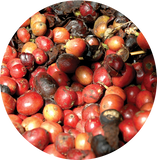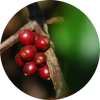
FEATURED

FEATURED
There are over 100 coffee species, however the two main ones that are widely produced and sold are: Coffea Arabica and Coffea canephora (also known as Coffea robusta).
Here’s a list featuring 10 differences between the two coffee species:

Every Monday morning we understand the magical properties of a cup of coffee as it gives us that boost to get the week started. However, does drinking it do more for you and your taste-buds than what you originally anticipated?
When we went to visit one of our featured roasters from the September issue, Propeller Coffee Co., outside of the front of their café/roaster was an entertaining sign that read: “They say money can’t buy happiness. We say money can buy coffee. And that’s pretty close. Happiness Brewing here.”
It got us thinking. We dug into some scientific journals to see if there were any studies out there that helped answer this question: Does coffee improve happiness?

That skin on the fruit of the coffee cherry, also known as the coffee husk (‘husk’ or ‘skin’ translated in Spanish is Cascara, hence the name) is usually either a wasted product of coffee production or used as a fertilizer.
However it can actually make quite a tasty beverage.

If you haven’t heard of Kopi Luwak, you might know it by what it’s most commonly called – “that cat poo coffee”.
It’s an Indonesian coffee product that has garnered a lot of attention specifically for the fact that a cat/raccoon like animal, the Asian Palm Civet, eats the coffee berry and digests it. From there the coffee is extracted from the excrement, roasted and brewed. Something that has been defecated ruins all preconceived notions of what should taste good - however it’s garnered the allure and the reputation of being the tastiest coffee available.

If you’re an avid coffee drinker there are a few options to make your joe better suited for the summer weather. You can go the cold brew route or you can make an iced coffee. Cold brewing can takes about 12 – 18 hours, and we don’t always have that much foresight when we want something caffeinated and cold... which is where a fantastic iced coffee comes into play.
So what are your iced coffee options? We have 3 delicious recipes that are a bit more unique than the rest – one from us, one from the gents over at Hale Coffee (which uses ice cream) & one from de Mello Palhetta (which uses peppermint tea!).

Michael King, owner of Bean North, explains the effect “It is basically devastating the coffee harvest in Central America right now where countries like Guatamala are down 60%. Some of the cooperatives we’ve purchased from for years – like one in El Salvador, has 0 coffee to export this year.”
“It’s so beautiful to see this”
This is the specific bloom he was referring to was this: